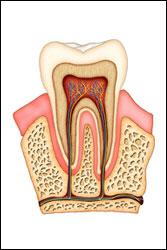
- posted: Sep. 10, 2018
 Could your smile be trying to tell you that something is wrong?
Could your smile be trying to tell you that something is wrong?
Okay, so root canals haven’t gotten the best reputation over the years, but our Kinnelon, NJ, dentist Dr. Peter Brusco is here to tell you more about this procedure to ease your mind, particularly if you need to have one done.
First and foremost, root canal treatments happen all the time and really aren’t any more invasive than getting a dental filling. Furthermore, it could just end up saving your tooth from needing an extraction while also getting rid of that nasty toothache you’re experiencing.
So, what is a root canal?
It’s important to understand this procedure so that you understand the purpose behind it and why it’s necessary. This isn’t an elective dental procedure; it is one you will need if you want to treat a damaged tooth and prevent further damage from happening.
Deep inside, under the enamel and dentin layers of the tooth, lies a soft tissue structure known as the dental pulp. While the dental pulp is an important part of the tooth while it’s developing, once the tooth has fully matured the dental pulp no longer serves a purpose.
However, sometimes bacteria can break through these hard outer layers of the tooth, getting inside and infecting the pulp. Once this happens, our Kinnelon, NJ, general dentist has no choice but to remove the dental pulp. The purpose behind root canal treatment is to:
- Remove the dental pulp
- Disinfect the inside of the tooth and the root canals
- Prevent bacteria from spreading
- Fill the canals with special material to prevent a re-infection
- Restore the tooth’s strength and function
How do I know that I need a root canal?
A lot of people may require a root canal but feel absolutely fine and not even notice any symptoms. While we know this thought can be unnerving this is why it’s important to visit your dentist every six months for checkups, even if you think everything feels fine.
Of course, if the dental pulp is infected, often times the most classic symptom is a toothache. After all, the dental pulp is made up of nerves, so when bacteria infect it, it will certainly let you know by causing you pretty persistent and sometimes severe pain.
Besides pain, you may also notice increased sensitivity to hot or cold foods or drinks. Sensitivity can linger long after you’ve had contact with the offending beverage or food. If a toothache goes ignored and the tooth doesn’t get the care it needs sometimes the tooth will begin to darken. This means the roots of the tooth are dying. You may also notice redness, swelling or tenderness in the gums surrounding that tooth.
If you are experiencing any of these symptoms it’s best to play it safe and give our Kinnelon, NJ, family dentist a call. We will go through your symptoms and determine whether you need to come in right away for care. Don’t put off the treatment your smile needs to stay healthy.

